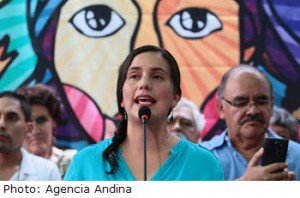OAS pooh-poohs April 10 presidential, congressional elections as only “semi-democratic”
By Nicholas Asheshov ✐
 The last week before the elections on April 10 saw two new developments.
The last week before the elections on April 10 saw two new developments.
One was the solid gain in the polls by Veronica Mendoza, leading her far-left Frente Amplio party. The latest polls show her a point or two only behind second-place Pedro Pablo Kuczynski. If this trend continues and is reflected in Sunday’s voting, Mendoza will be the one, not PPK, facing Keiko Fujimori in the run-off on June 5.
Fujimori continued, in the polls, way ahead at over 35 percent, of PPK and Mendoza. IPSOS, the most consistent of the pollsters, put PPK at 16.8 percent and Mendoza at 15.5 percent.
PPK has been at 15-16 percent for the past few weeks. Mendoza has, however, jumped out of single digits in the past few weeks. In 2011, PPK in his first run for the presidency received 18 percent of the votes, third behind Fujimori, who had 23 percent, and Ollanta Humala with 31 percent.
Humala won the run-off 51-49.
The other development was a Twitter statement from the Organisation of American States, in Washington, that the Peru elections are only “semi-democratic.” This came from the secretary general of the OAS, an Uruguayan, Luis Almagros, following a meeting with Julio Guzman, the Peruvian ex-candidate who was scratched from the list several weeks ago.
The elections board in Lima said, as they had done several times, he and his small rent-a-party had not complied with the election rules. He had been second, a new face, in the polls at the time. He and his supporters, which include the Humalas, say this was ‘electoral fraud.’ President Humala himself wrote shortly afterwards in reference to his own Nationalist Party, there were no longer “proper guarantees” for the elections.
The OAS is a light, low-function outfit on the fringe of Washington’s official lobby groups. It is staffed by politicos and passed-over bureaucrats from the Latin countries, each of which has a quota.
However, despite the low rating in Washington of the OAS, the catchy “semi-democratic” slur has an undoubted effect. Guzman was secretary to the ministerial cabinet 2012-13 when Juan Jimenez, a close associate of President and Mrs. Humala, was Prime Minister. Since then Jimenez has been Peru’s ambassador to the OAS. The effects of the OAS ‘semi-democratic’ label, which has not been challenged by the Humala government, can be summed up as:
- If the Mendoza Frente Amplio were to win the run-off in June, the OAS will see this as democratic. Mendoza, 35, has been a close associate of Nadine Heredia, Mrs. Humala.
Mendoza has been questioned by some of the dozen or so congressional committees and investigating magistrates looking into the accusations of colourful money-laundering that have helped bring the Humala public approval ratings today close to single digits.
Mendoza, who has a French passport, won a seat in Congress in the 2011 elections on the Humala Nationalist Party ticket, but defected in 2012 to form her own caucus and party. Her congressional candidates include people associated with violent anti-mining clashes and with organisations associated by the Lima media with terrorist or former terrorist groups. - If the Fujimori Fuerza Popular wins and Keiko F becomes the elected President, this will show the elections as, indeed, ‘semi-democratic’ and open to legal and political questioning and skirmishes from the losers, an annoyance and maybe worse.
- If Kuczynski, 77, wins the run-off, this will scrape past the OAS and related judges. PPK has no political luggage, for good or ill.
But the Fujimori people are shadowed by a political cloud as undemocratic, unconstitutional, tarnished by corruption with its leader, ex-President Alberto F, doing a 25-year sentence for human rights violations. The polls say 40 percent of the voters retain this view, so it is a mathematical, as well as a political reality right now.
It may be the big factor in the second round in June. Ms. F would, the polls, say, beat Mendoza in June as most of PPK’s people, plus many also-rans would put Ms. F over the top. This on the grounds they dislike extreme Left more than the unfortunate history represented by Ms. F’s name.
However, if PPK this Sunday, April 10, makes the run-off against Ms. F, the hard-core anti-F would unite with the many other shades of Left to put PPK past Ms. F.
That, at any rate, is what the polls have been saying. It would also help to cool political tensions and, as a free bonus, provide Peru with a decent government.
Nick Asheshov was editor of the Andean Air Mail & Peruvian Times during the 1970s and 1980s, and of The South Pacific Mail, Santiago during the 1990s. He was Latin America Editor of Institutional Investor, New York over the same period. He lives in Urubamba, where he writes a blog and where he has been prominent in the hotel and railway business.





